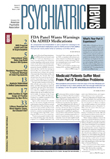Time erases memories, memories of people who have made great accomplishments during their lifetimes. One such person was Marion Edwina Kenworthy, M.D. At a time when women physicians occupied subservient places in medicine and psychiatry, she found ways to use her knowledge, skills, and personality to improve the world. She was the first woman vice president of APA (1965-66); the first woman president of the American Psychoanalytic Association (1958-59), American Academy of Child Psychiatry (1959-61), and Group for the Advancement of Psychiatry (1959-60); the recipient of the APA Agnes Purcell McGavin Award for astounding contribution to child psychiatry (1971); recipient of honorary degrees from the Women's Medical College in Philadelphia (doctor of medical science, 1968) and Columbia University (doctor of science, 1973). She was a pioneer in teaching psychiatry in social work.
Kenworthy was born in Hamden, Mass. She received a medical degree from Tufts in 1913. She then spent three years at the Garden State Hospital and three years at Foxboro State Hospital, both in Massachusetts. She also spent time at the Boston Psychopathic Hospital and the Judge Baker Guidance Clinic.
In 1919 Kenworthy moved to New York City, serving as an assistant at the Vanderbilt Clinic and Neurology Institute. In 1921 she underwent a training analysis with Otto Rank. That year she affiliated with the Bureau of Child Guidance, soon becoming its director. She also began to teach psychiatry at the New York School of Social Work (soon to become part of Columbia University). She taught psychiatry to hundreds of social workers until 1956, when she retired to become professor emerita. At her retirement, the Marion E. Kenworthy Professorial Chair in Psychiatry was established at the School of Social Work in her honor.
Kenworthy's activities were manifold, especially in serving on boards of directors and on committees. She was active with the National Association for Mental Health, N.Y. State Charities Aid Association, National Conference of Social Workers, Wiltwyck School for Boys (which she helped establish), the Menninger Foundation board, and others. She was a charter member of the American Orthopsychiatric Association, a life fellow of the New York Academy of Medicine, and an associate member of the World Federation for Mental Health. She worked with the Children's Court in New York.
During World War II, Kenworthy helped establish Selective Service criteria, was appointed to the National Civilian Advisory Committee for the Women's Army Corps, helped to provide the impetus for mental hygiene clinics in the military, and promoted the status of social work. She provided consultation to the U.S. Public Health Service from 1946 to 1950.
Kenworthy collected books. She donated 50 books of rare quality (16th- to 19th-century publications) and 65 pamphlets, mainly from the 19th century, to APA.
On September 9, 1988, APA dedicated the Marion E. Kenworthy Learning Center in the Library in its headquarters at the time in Washington, D.C. A conference room named in her honor and furnished with audiovisual equipment for learning and research is now a part of APA's new headquarters in Arlington, Va. The Kenworthy donation has been integrated with the rare-book collection in APA's library.
Viola Bernard, M.D., Kenworthy's friend and colleague, wrote of her:“ [S]he was a compassionate, generous, and gifted clinician, teacher, and administrator.... Her way of living her life has made an immense difference... in the lives of many people.... She gave of her wisdom, hard work, and organizational ability....” ▪
